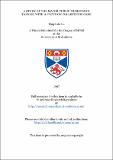Files in this item
A study of the major public museums in Taiwan, with a focus on collections care
Item metadata
| dc.contributor.advisor | Carradice, Ian | |
| dc.contributor.author | Lu, Ying-hsiu | |
| dc.coverage.spatial | 152 p. | en_US |
| dc.date.accessioned | 2018-07-09T13:23:58Z | |
| dc.date.available | 2018-07-09T13:23:58Z | |
| dc.date.issued | 1997 | |
| dc.identifier.uri | https://hdl.handle.net/10023/15129 | |
| dc.description.abstract | The origins of museum development in Taiwan date back to the late nineteenth century; however, little was achieved until recently because of Taiwan's unstable social and political situation in the early to mid-twentieth century. People outside Taiwan's major cities had very few opportunities to enjoy museums or other cultural services and facilities; and providing the public with such services and facilities was not considered as important as national economic and industrial construction in the viewpoint of Taiwan's government. But now the situation has changed. According to official statistics published by the Council for Cultural Planning and Development, the central government's cultural policy maker, Taiwan's museums have quadrupled within the last two decades: in 1970 there were only 30 museums in Taiwan, but in 1993 this number had grown to 121. This statistic not only shows that the museum industry has become prosperous, with more and more museums, both public and independent, being founded in recent years, but also that people in Taiwan now have more opportunities to enjoy such facilities and services. This thesis begins with an introduction to the history of museum development in China and Taiwan, followed by a discussion of the current museum system in Taiwan. Having been ignored for a long time by the government, Taiwan's museum system is usually considered unsound by local artists and professionals in related fields, Public museums in Taiwan have always been operated as social educational organisations and there is a concern that more laws regarding museum management should be enacted in Taiwan. For purposes of comparison, Japan's museum system and cultural policy are also discussed. Both countries have been at the forefront of Asia's booming economy, so the comparison might be useful in identifying the strengths and weaknesses of Taiwan's museum system and may provide a model for its future development. The last part of the thesis focuses on the care of collections at the six major public museums in Taiwan. As the conservation/care of museum collections has become a major issue world-wide in recent years, it is interesting to see what has been achieved in Taiwan and what the government's attitude towards conservation has been. | en_US |
| dc.language.iso | en | en_US |
| dc.publisher | University of St Andrews | |
| dc.subject.lcc | AM133.T2L9 | en |
| dc.subject.lcsh | Museums—Collection management | en |
| dc.title | A study of the major public museums in Taiwan, with a focus on collections care | en_US |
| dc.type | Thesis | en_US |
| dc.type.qualificationlevel | Masters | en_US |
| dc.type.qualificationname | MPhil Master of Philosophy | en_US |
| dc.publisher.institution | The University of St Andrews | en_US |
This item appears in the following Collection(s)
Items in the St Andrews Research Repository are protected by copyright, with all rights reserved, unless otherwise indicated.

